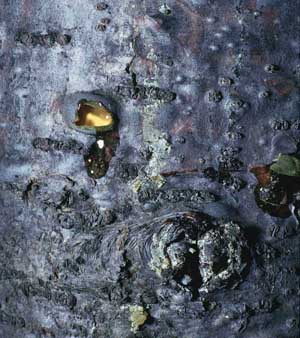|
|
 52 microscope slide mounts DHJanzen100290.jpg high resolution
|
|
| When you found yourself peering through a microscope at a slide-mounted small invertebrate or tissue slice, you may well have been peering through the resin in this pocket in the bark of a Canadian balsam fir tree. The pure liquid resin collected from wounded balsam fir bark was, and still is in some places, the medium of choice for slide-mounting small objects (though modern synthetics today work better in some cases). This resin gradually sets into a rock-hard clear material (essentially, amber) which is close to being biologically non-degradable. It does make one wonder why the world is not two meters deep in resin. Undoubtedly there are combinations of microbes and physical conditions under which conifer resins do biodegrade, but these are not found in the protected dry laboratory on a glass slide. In case you have any doubts as to the defensive role of conifer resins, just try chewing on pine needles or the bark of your next Christmas tree. | ||
back to lecture slides
or skip to: